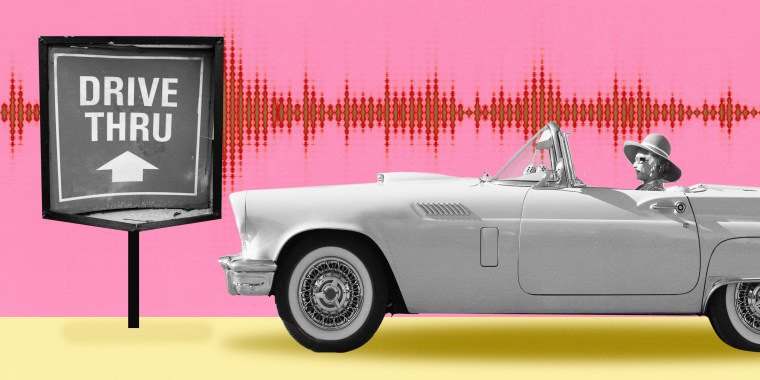As the COVID-19 pandemic continues, many Americans have turned to the drive-thru as a safer means of picking up food. For some, the voice on the speaker by the menu board may be the only other person they interact with all day. But a new wave of technology that is set to transform the fast food industry may change all that. The next time you order a value meal, it might be the equivalent of Siri or Alexa taking your order. As artificial intelligence (AI) continues to play a big role in our daily lives, customers should prepare for an automated voice to ask: Do you want fries with that?
Voice automation is nothing new — if you've ever tried to get a customer service representative on the line, you're familiar with the robotic prompt that tells you to press one for more options. But the type of AI that fast food chains are turning to is worlds more advanced than the voice that really, really doesn't want you to speak to a representative. Innovators like Rob Carpenter, founder of Valyant AI, say that the use of AI at the drive-thru is set to take off in a major way over the next six months to a year.
It’s about giving customers choice. Not everyone is going to prefer automated, but a substantial part of the population will benefit.
Rob Carpenter, founder of Valyant AI
"AI is already a part of the drive-thru experience and it will only increase, that's the direction tech is moving in," Carpenter told TODAY Food. Some fast food restaurants including Sonic and McDonald's are already trying out the use of voice automation. Carpenter said that while the industry was already heading in this direction, the coronavirus pandemic definitely accelerated adoption. "It could have taken three to seven years and it will be more like one to two years," he said regarding more widespread use of the technology. Carpenter first launched his technology with Good Times Burgers in Denver, Colorado. Checkers in Atlanta just signed on with the company to modernize its drive-thru experience.
And while AI will certainly give customers a speedier drive-thru experience, Carpenter says that it's actually the on-site staff that will benefit the most from adoption of the tech.
"Taking orders is thankless," said Carpenter. "It's one of the least desired jobs of fast food employees. It can be monotonous. By automating this, employees can focus on other jobs, such as making food."
AI won't totally eliminate all human contact, said Carpenter.
"When they pull up to get their food, they can have a friendly face-to-face," he said. Carpenter compares the AI experience to the self-checkout lines at grocery stores. "If you only have five items, it's more efficient," he said. "It’s about giving customers choice. Not everyone is going to prefer automated, but a substantial part of the population will benefit."
Eerily, Carpenter said that because the new technology is so advanced, using it is more like conversing with an actual human than ever before. That's not to say there won't be some mistakes along the way.
"We’re going to ask for the customer to meet us part way," he said. "Sometimes you might need to say, 'remove that item' or 'start over.' These systems have a rudimentary common sense built in."
This means that when you order a chicken sandwich automated voices will know not just to ask you if you want to make it a combo, but also what kind of drink you want.
Carpenter estimates that this new technology will have a massive impact on the fast food industry's bottom line, and not just because they will be getting more cars through, faster.
"There's also a higher rate of successful upsells," he said, referring to when a team member asks if you'd like a muffin with that coffee or an apple pie with your value meal. "The AI can double the number of successful upsells, and it's simply because the AI is more consistent about asking." While an employee can get tired, unmotivated or simply forget, AI never forgets.
Carpenter said he doesn't view these advances as a road to job loss for employees. "It's task automation," he said. "That order taker position is processing credit cards, filling soft drinks, doing four, five, six jobs simultaneously. The order taking is 50 percent of workload. We’re freeing them up to further improve the drive-thru experience."
Mason Smoot, senior vice president and chief restaurant officer for McDonald's USA, said in a November 2020 investor update that McDonald's is seizing many opportunities they see in drive-thru ordering — something the fast-food chain has been doing for over 45 years.
"It starts with speed of service," he said. "We've made smart investments the past few years to bolster the foundational elements — staffing, scheduling, positioning, and how we assemble orders."
He mentioned reduced menu complexity as one way the chain has improved speed of service, cutting drive-thru times down by 30 seconds in top markets.
Other options to improve speed and service include side-by-side drive-thru lanes, enabling two customers to order at the same time.
"We’re also testing automated order-taking in the drive-thru," he said. "This exciting technology is a product of the McDonald’s Tech Labs team. We’re able to greet customers in a consistent manner when they arrive, accurately take their order and thank them for visiting McDonald’s. Our customers like it because it makes their ordering process easier, and more streamlined, and crew are freed up to focus on other customer-facing activities."
Smoot said approximately 70% of sales in top markets happen in the drive-thru. "During COVID, we’ve seen a surge in guests using the McDonald’s mobile app to order and pay. They’ve appreciated convenient options for pickup at the drive-thru, and curbside delivery. Customers’ desire for convenience, speed, and ease will only grow and we’re ready for that," he said.


